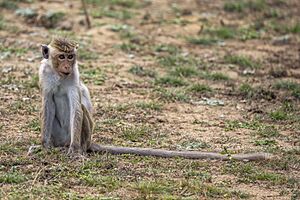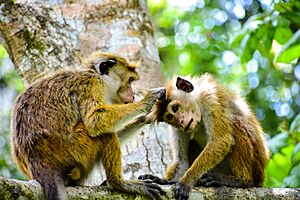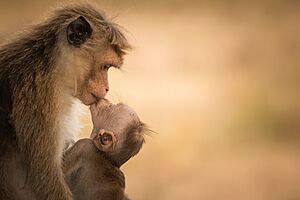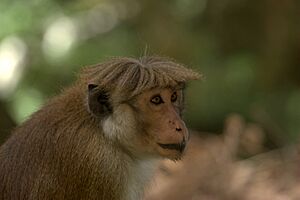Toque macaque facts for kids
Quick facts for kids Toque macaque |
|
|---|---|
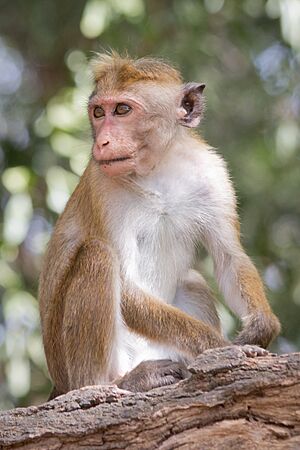 |
|
| Conservation status | |
| Scientific classification | |
| Genus: |
Macaca
|
| Species: |
sinica
|
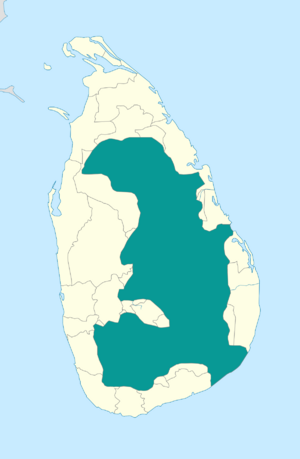 |
|
| Toque macaque range map | |
The toque macaque (pronounced 'tok muh-KAK') is a reddish-brown monkey. It lives only on the island of Sri Lanka. In Sri Lanka, people call it rilewa or rilawa. The monkey's name comes from the hair on its head. This hair looks like a special hat called a toque cap.
Contents
Monkey Family: Toque Macaque Types
Toque macaques belong to a group of monkeys called Old World monkeys. The name Macaca comes from a Portuguese word for monkey. The word sinica means "from China," but these monkeys do not live in China.
There are three types, or subspecies, of toque macaques:
- Macaca sinica sinica, also known as the dry zone toque macaque.
- Macaca sinica aurifrons, also called the wet zone toque macaque.
- Macaca sinica opisthomelas, known as the highland toque macaque.
You can tell these three types apart by the patterns and colors of the hair on their heads. For example, M. s. opisthomelas has longer fur. It also has a golden color on the front part of its brown head cap.
What Do Toque Macaques Look Like?
As female toque macaques get older, their faces can turn a light pink color. This is very easy to see in the M. s. sinica type.
Where Do Toque Macaques Live?
Each type of toque macaque lives in different parts of Sri Lanka:
- M. s. sinica lives in the dry, flat areas of Sri Lanka. You can find them in places like Vavuniya, Anuradhapura, and Polonnaruwa.
- M. s. aurifrons lives in the wetter, southwestern parts of the island. They are found near Galle and Matara. Sometimes, they live in the same areas as M. s. sinica.
- M. s. opisthomelas lives in the cooler, higher areas. These include the Ratnapura and Nuwara Eliya districts. They also live around places like Hakgala Botanical Garden.
Toque Macaque Life and Habits
Monkey Groups and Social Life
Toque macaques live in groups called troops. These troops have a clear social order, like a ladder. Both male and female monkeys have their own rank. A troop can have anywhere from 8 to 40 monkeys.
If a troop gets too big, the monkeys might start fighting more. This can cause some monkeys to leave the group. Young adult males often leave their birth group. Sometimes, new lead males can be aggressive. This might also cause females to leave. Fights can even lead to serious injuries, like broken arms.
Young monkeys born to the highest-ranking female usually get the best food and safest places to sleep.
Reproduction and Life Cycle
When a female macaque is ready to have babies, her body shows signs to males. This tells them she is ready to mate. On average, a female will have a baby every 18 months.
After being pregnant for 5 to 6 months, the female gives birth to one baby. The baby stays very close to its mother for about two months. During this time, the baby learns important social skills. These skills help it survive in the troop. A baby's social standing in the group comes from its mother's rank.
Young male macaques must leave their birth group when they are about 6 to 8 years old. This helps prevent them from mating with close family members. It also helps the current lead male keep his position. Leaving the troop is the only way a male can try to improve his social standing. If he is strong and has good social skills, he might become a lead male in a new troop. One lead male can father all the babies in his troop.
Giving birth usually happens away from the group. The mother will go about 100 meters away. She stands on two legs and uses her hands to help the baby come out. The baby is usually born very quickly. Babies can make sounds almost right away. It is important for the mother and baby to recognize each other's voices. These sounds help them find each other if they get separated. They also warn the mother of danger. After birth, the mother cleans the baby and helps it find her milk. She will start looking for food again within 20 minutes.
What Do Toque Macaques Eat?
Toque macaques eat many different things. One study found their diet included:
- 77% fruits
- 14% flowers
- 5% mushrooms
- 4% small animals
They really like fruits from certain trees, like Ficus bengalensis and Schleichera oleosa. During the rainy season, they look for mushrooms.
Toque macaques have special cheek pouches. These pouches let them store food quickly while they are eating. In dry areas, they eat fruits from shrubs like Zizyphus and figs. Sometimes, they also eat small animals. These can be insects or even small mammals like the Indian palm squirrel.
Who Hunts Toque Macaques?
The main animals that hunt toque macaques are wild cats. These include leopards and fishing cats. Large snakes like the Indian rock python also hunt them.
Protecting Toque Macaques
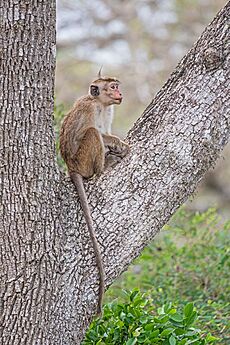
The toque macaque is listed as an Endangered animal. This means it is at high risk of disappearing forever. The main reasons for this are:
- Habitat loss: Their forest homes are being destroyed. Between 1956 and 1993, half of Sri Lanka's forests were lost. People cut down trees for farms and for firewood.
- Hunting: They are hunted for food.
- Pet trade: Some people catch them to sell as pets. Both the M. s. aurifrons and M. s. sinica types are sometimes kept as pets.
Recently, there has been a plan to send many monkeys from Sri Lanka to China. This plan has caused a lot of concern among people who work to protect animals.
Images for kids



